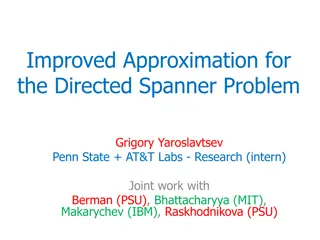Distributed Transactions and Spanner Overview
Explore concepts like serializability, partitioned data handling, achieving serializability in distributed settings, consensus per transaction group, and insights into Google's Spanner database, focusing on its globally distributed design and fault tolerance mechanisms.
Uploaded on Dec 07, 2024 | 0 Views
Download Presentation

Please find below an Image/Link to download the presentation.
The content on the website is provided AS IS for your information and personal use only. It may not be sold, licensed, or shared on other websites without obtaining consent from the author. Download presentation by click this link. If you encounter any issues during the download, it is possible that the publisher has removed the file from their server.
E N D
Presentation Transcript
Distributed Transactions and Spanner COS 418: Distributed Systems Lecture 19 Michael Freedman
Serializability Execution of a set of transactions over multiple items is equivalent to some serial execution of txns 2
Consider partitioned data over servers R L U O L R W U P L W U Q Why not just use 2PL? Grab locks over entire read and write set Perform writes Release locks (at commit time) 4
Consider partitioned data over servers R L U O L R W U P L W U Q How do you get serializability? On single machine, single COMMIT op in the WAL In distributed setting, assign global timestamp to txn (at sometime after lock acquisition and before commit) Centralized txn manager Distributed consensus on timestamp (not all ops) 5
Strawman: Consensus per txn group? R L U O L R W U P L W U Q R S Single Lamport clock, consensus per group? Linearizability composes! But doesn t solve concurrent, non-overlapping txn problem 6
Spanner: Googles Globally- Distributed Database OSDI 2012 7
Googles Setting Dozens of zones (datacenters) Per zone, 100-1000s of servers Per server, 100-1000 partitions (tablets) Every tablet replicated for fault-tolerance (e.g., 5x) 8
Scale-out vs. fault tolerance O OO P PP QQQ Every tablet replicated via Paxos (with leader election) So every operation within transactions across tablets actually a replicated operation within Paxos RSM Paxos groups can stretch across datacenters! 9
Disruptive idea: Do clocks really need to be arbitrarily unsynchronized? Can you engineer some max divergence? 10
TrueTime Global wall-clock time with bounded uncertainty Timestamps become intervals, not single values TT.now() time earliest latest 2* Consider event enow which invoked tt = TT.new(): Guarantee: tt.earliest <= tabs(enow) <= tt.latest 11
Timestamps and TrueTime Acquired locks Release locks T Pick s > TT.now().latest s Wait until TT.now().earliest > s Commit wait average average 12
Commit Wait and Replication Start Achieve consensus Notify followers consensus Acquired locks Release locks T Pick s Commit wait done 13
Client-driven transactions Client: 1. Issues reads to leader of each tablet group, which acquires read locks and returns most recent data 2. Locally performs writes 3. Chooses coordinator from set of leaders, initiates commit 4. Sends commit message to each leader, include identify of coordinator and buffered writes 5. Waits for commit from coordinator 14
Commit Wait and 2-Phase Commit On commit msg from client, leaders acquire local write locks If non-coordinator: Choose prepare ts > previous local timestamps Log prepare record through Paxos Notify coordinator of prepare timestamp If coordinator: Wait until hear from other participants Choose commit timestamp >= prepare ts, > local ts Logs commit record through Paxos Wait commit-wait period Sends commit timestamp to replicas, other leaders, client All apply at commit timestamp and release locks 15
Commit Wait and 2-Phase Commit Acquired locks TC Acquired locks TP1 Acquired locks TP2 Compute sp for each 1. Client issues reads to leader of each tablet group, which acquires read locks and returns most recent data 16
Commit Wait and 2-Phase Commit Start logging Done logging Acquired locks TC Acquired locks TP1 Acquired locks TP2 Prepared Send sp Compute sp for each 2. 3. 4. Locally performs writes Chooses coordinator from set of leaders, initiates commit Sends commit msg to each leader, incl. identity of coordinator 17
Commit Wait and 2-Phase Commit Start logging Done logging Acquired locks Release locks TC Committed Notify participants sc Acquired locks Release locks TP1 Release locks Acquired locks TP2 Prepared Send sp Compute sp for each Commit wait done Compute overall sc 5. Client waits for commit from coordinator 18
Example Remove X from friend list Risky post P TC T2 sp= 6 sc= 8 s = 15 Remove myself from X s friend list TP sp= 8 sc= 8 Time <8 8 15 [X] [] My friends My posts X s friends [P] [me] [] 19
Read-only optimizations Given global timestamp, can implement read-only transactions lock-free (snapshot isolation) Step 1: Choose timestamp sread = TT.now.latest() Step 2: Snapshot read (at sread) to each tablet Can be served by any up-to-date replica 20
Disruptive idea: Do clocks really need to be arbitrarily unsynchronized? Can you engineer some max divergence? 21
TrueTime Architecture GPS GPS GPS timemaster timemaster timemaster GPS Atomic-clock timemaster GPS timemaster timemaster Client Datacenter 1 Datacenter 2 Datacenter n Compute reference [earliest, latest] = now 22
TrueTime implementation now = reference now + local-clock offset = reference = 1ms + worst-case local-clock drift + 200 s/sec +6ms time 0sec 30sec 60sec 90sec What about faulty clocks? Bad CPUs 6x more likely in 1 year of empirical data 23
Known unknowns > unknown unknowns Rethink algorithms to reason about uncertainty 24








